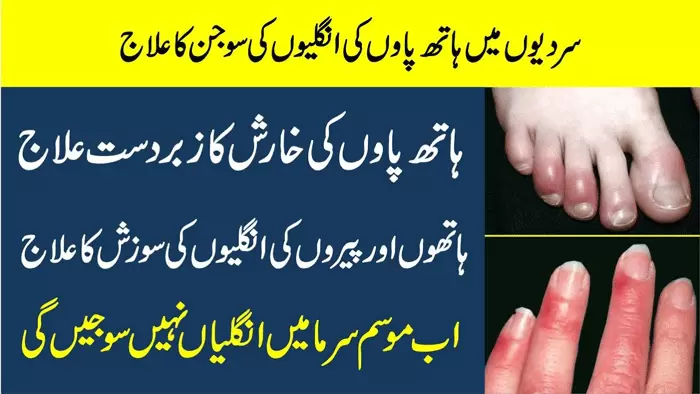
Winter is a season of chilly winds, cozy blankets, and festive cheer. However, it also brings along some unwelcome guests chilblains. If you’ve ever experienced swollen fingers during the colder months, chances are you’ve encountered these pesky nuisances. In this article, we’ll explore what chilblains are, why they occur, and most importantly, how to prevent them from making your winter less enjoyable.
What Are Chilblains? Chilblains, also known as perniosis, is an inflammatory skin condition that occurs when the skin is exposed to cold and damp conditions for an extended period. While they may not be as well-known as frostbite, chilblains can cause discomfort and affect the extremities, especially the fingers and toes.





Why Do They Occur?
Chilblains develop when the blood vessels in the skin respond abnormally to sudden changes in temperature. When exposed to cold, the blood vessels may constrict to preserve heat, and upon warming, they may fail to open properly, leading to inflammation and swelling. This abnormal response is more common in individuals with poor circulation or a family history of chilblains.
Recognizing Chilblains Symptoms
Identifying the Signs
Recognizing chilblains early is crucial for effective management. Symptoms include red or purple discoloration, swelling, itching, and a burning sensation in the affected areas. In severe cases, blisters and ulcers may develop.
Common Locations
Chilblains often target areas that are more prone to cold exposure, such as fingers, toes, ears, and the nose. For those spending extended periods outdoors or with poor insulation, the risk of developing chilblains increases.
Tips to Avoid Chilblains
Keep Warm with Layering
One of the simplest yet most effective ways to prevent chilblains is by layering up. Wear warm clothing, including gloves and socks, to maintain body heat and protect your extremities from the harsh winter elements.
Gradual Warming
Avoid sudden temperature changes, especially when coming indoors after being outside in the cold. Gradual warming allows your blood vessels to adjust to the change in temperature, reducing the risk of chilblains.
Stay Dry
Moisture is a friend to chilblains, so keeping your skin dry is crucial. Invest in waterproof and insulated footwear to protect your feet from dampness, and always dry your hands and feet thoroughly after being exposed to wet conditions.
Maintain Good Circulation
Regular exercise is not only beneficial for your overall health but also helps maintain good circulation, reducing the likelihood of chilblains. Simple activities like walking, jogging, or even stretching can make a significant difference.
Protect Your Extremities
Use protective clothing and accessories to shield your fingers, toes, ears, and nose from the cold. Invest in high-quality gloves, warm socks, and earmuffs to create a barrier between your skin and the winter chill.
Choose the Right Footwear
Ensure your footwear is appropriate for the weather conditions. Insulated and waterproof boots can provide much-needed protection against cold and dampness, minimizing the risk of chilblains on your toes.
Apply Moisturizer
Keep your skin well-moisturized to prevent dryness and cracking. Use a moisturizer that suits your skin type, paying special attention to your fingers and toes. Well-hydrated skin is less susceptible to chilblains.
Q1: Can Anyone Get Chilblains, No Matter How Old?
A1: Yes, chilblains can happen to people of all ages, especially those with poor blood circulation or who are sensitive to the cold. While older adults and young kids might be more at risk, anyone spending lots of time in the cold needs to be careful.
Q2: Do Chilblains Only Happen in Winter?
A2: Chilblains are most common in winter, but they can also happen in late fall and early spring. Even though the article talks about winter, it’s important to be cautious during the times when the weather is changing.
Q3: Does Family History Matter for Chilblains?
A3: Yes, your family history can make you more likely to get chilblains. If others in your family have had them, you might be more prone to this condition. While where you are matters, your genes can also play a part.
Q4: Can Chilblains Cause Big Problems?
A4: Usually, chilblains go away on their own once you warm up your skin. But if you keep getting them, they might lead to more serious issues like sores or infections. If your symptoms don’t get better, it’s important to see a doctor.
Q5: Can Eating Certain Foods Help Avoid Chilblains?
A5: Yes, certain foods can help your skin stay healthy and prevent chilblains. Foods with antioxidants and omega-3 fatty acids, like berries, nuts, and fatty fish, can make your skin stronger. Eating a good mix of foods helps your body handle the cold better.
Make sure winter stays comfy by stopping chilblains in their tracks. Learn what they are and do easy things to prevent them. Keep your fingers warm and happy. Feel confident in winter, knowing how to keep these cold troubles away. A bit of preparation makes winter more fun. Stay warm, stay dry, and enjoy the season without any discomfort.







